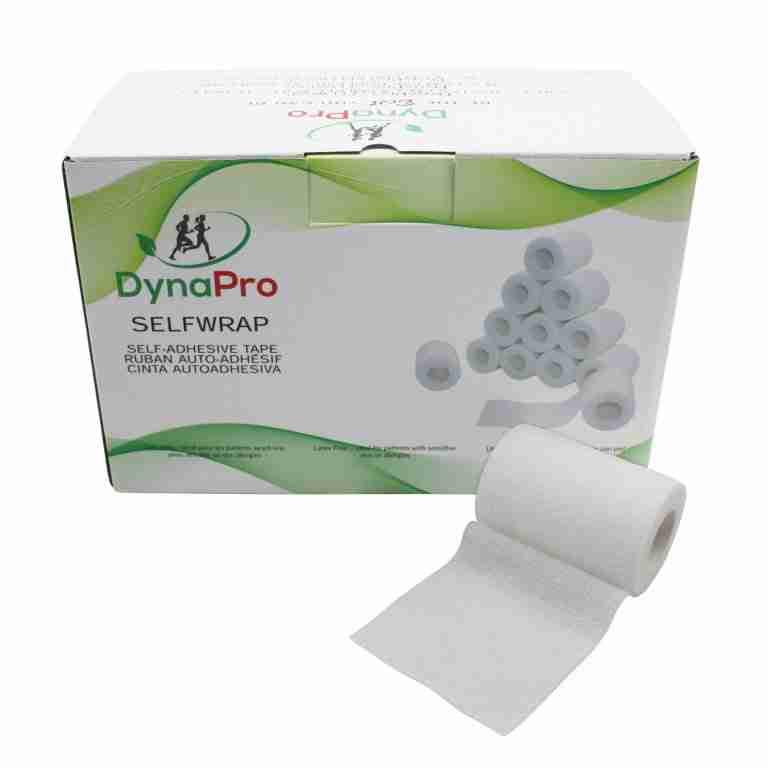8 Useful Guidelines For Choosing An Athletic Tape For Shoulder Injuries
In this post, we will consider the types of athletic tape that may be used to treat a shoulder injury. We will then suggest guidelines for choosing an athletic tape for shoulder injury treatment.
Introduction
Athletic tape can be used to provide support and stability for various shoulder injuries. Although it is important to note that athletic tape does not treat the underlying condition, it can help manage symptoms and facilitate the healing process. An athletic tape for shoulder injury treatment works by helping to prevent stress on the injured ligaments, tendons and muscles, therefore allowing them to heal more quickly.
Here are some types of shoulder injuries that can be supported with athletic tape:
- Shoulder Sprain/Strain: Athletic tape can help stabilize and support the shoulder joint in cases of sprains or strains, reducing excessive movement and providing some relief.
- Rotator Cuff Tendinitis: Tendinitis of the rotator cuff can cause pain and inflammation. Athletic tape can be applied to offload the affected tendons, providing support and reducing stress on the injured area.
- AC Joint Sprain: An acromioclavicular (AC) joint sprain is a common shoulder injury. Athletic tape can help provide compression and stability to the AC joint, promoting proper alignment and reducing pain.
- Shoulder Impingement: Shoulder impingement occurs when the tendons of the rotator cuff become compressed or irritated. Athletic tape can be used to create a “lift-off” effect, creating space in the shoulder joint and relieving pressure on the affected structures.
- Shoulder Instability/Subluxation: In cases of shoulder instability or subluxation (partial dislocation), athletic tape can help provide additional support and prevent excessive movement, reducing the risk of further injury.
- Labral Tears: Labral tears are injuries to the cartilage that surrounds the shoulder joint. While surgical intervention may be necessary in severe cases, athletic tape can provide temporary support and stability during rehabilitation.
Types of Athletic Tape For Shoulder Injury Treatment
There are several types of athletic tape that may be suitable for treating shoulder injuries. The choice of tape depends on individual preferences, the specific injury, and the desired level of support. Here are some types of athletic tape commonly used for shoulder injuries:
- Rigid Tape: Rigid athletic tape, also known as non-elastic or zinc oxide tape, is a stiff and durable tape that provides excellent stability and support. It is commonly used for immobilization and restricting excessive joint movement. Rigid tape is ideal for supporting AC joint sprains or providing added stability in cases of shoulder instability. Probably the best known examples of the use of rigid athletic tape for shoulder injury treatment are the McConnell Taping Series pioneered by Australian physiotherapist Jenny McConnell.
- Elastic Tape: Elastic athletic tape, such as kinesiology tape or elastic adhesive bandages, is stretchable and allows for a greater range of motion. It provides support while maintaining flexibility. Elastic tape is often used for conditions like rotator cuff tendinitis or shoulder impingement, where moderate support and pain relief are desired without restricting movement. The video above illustrates an example of the use of kinesiology tape for treatment of a shoulder injury.
- Pre-Cut Shoulder Tape: Because of the highly contoured shape of the shoulder, some manufacturers offer pre-cut athletic tape specifically designed for shoulder injuries. These pre-cut tapes often have a specific shape that fits the contours of the shoulder, making application easier and more targeted. They are available in both rigid and elastic versions.
- Cohesive Tape: Cohesive athletic tape, also known as self-adherent or cohesive bandages, adheres only to itself and does not stick to the skin or hair. It provides light support, compression, and gentle stabilization. Cohesive tape is commonly used for mild shoulder strains or for securing dressings or padding in place.
- Underwrap: Underwrap is a thin foam or fabric material used as a protective layer beneath athletic tape. It helps prevent skin irritation and provides a barrier between the skin and tape. Underwrap is often used in conjunction with rigid or elastic tape to enhance comfort during application.
Choosing an Athletic Tape for Shoulder Injury Treatment

When choosing an athletic tape for shoulder injury treatment, it is important to consider several criteria to ensure the tape is suitable and effective for your specific needs. Here are some key criteria to keep in mind:
- Support Level: Assess the level of support required for your shoulder injury. Some injuries may benefit from rigid tape that provides strong stability, while others may require more flexibility and range of motion provided by elastic tape. Determine whether you need maximum support, moderate support, or light support.
- Injury Type: Different shoulder injuries may require specific tape qualities. For instance, AC joint sprains may benefit from rigid tape that can immobilize the joint, while rotator cuff tendinitis may benefit from elastic tape that offers support while allowing movement. Consider the specific injury you are dealing with and any specific requirements it may have.
- Comfort and Feel: Comfort is crucial when using athletic tape. Consider the feel of the tape on your skin and whether it causes any irritation or discomfort. Look for tape with smooth edges and consider using underwrap or padding beneath the tape for added comfort.
- Skin Sensitivity and Allergies: If you have sensitive skin or known allergies to certain materials, select tape that is hypoallergenic or specifically designed for sensitive skin. It is essential to avoid any adverse reactions or skin irritations.
- Durability and Longevity: Assess the durability and longevity of the tape. Determine whether the tape will hold up well during activity and how long it is expected to last without losing its adhesive properties. This is particularly important if you need the tape to stay in place for an extended period.
- Ease of Application and Removal: Consider the ease of application and removal of the tape. Some tapes may require professional assistance for proper application, while others are designed for self-application. Choose a tape that suits your level of comfort and familiarity with taping techniques.
- Breathability and Sweat Resistance: Look for tape that is breathable and sweat-resistant. Adequate breathability prevents excessive moisture buildup and allows the skin to breathe, reducing the risk of skin irritation. Sweat resistance helps the tape maintain its adhesion and effectiveness during physical activity.
- Cost: Evaluate the cost of the tape, considering your budget and the frequency of tape application that may be required for your treatment. Balance cost with the desired quality and features of the tape.
Conclusion
In this article, we have explored various aspects of the subject of using athletic tape for shoulder injury treatment.
It is important to consult with a healthcare professional, such as a sports medicine physician or physical therapist, for an accurate diagnosis and proper treatment plan. They can assess the specific shoulder injury and determine if athletic taping is appropriate and how it should be applied. They can also guide you on exercises, stretches, and other treatments to address the underlying condition.
When choosing an athletic tape for shoulder injuries, it is essential to consider factors such as the level of support required, the type of shoulder injury, personal comfort, and any allergies or sensitivities to certain materials. It is recommended to consult with a healthcare professional, such as a sports medicine physician or physical therapist, who can provide specific recommendations based on your individual needs and injury. They can guide you on the most appropriate type of athletic tape and demonstrate proper application techniques.
Please remember to leave comments and/or questions in the space provided below.







